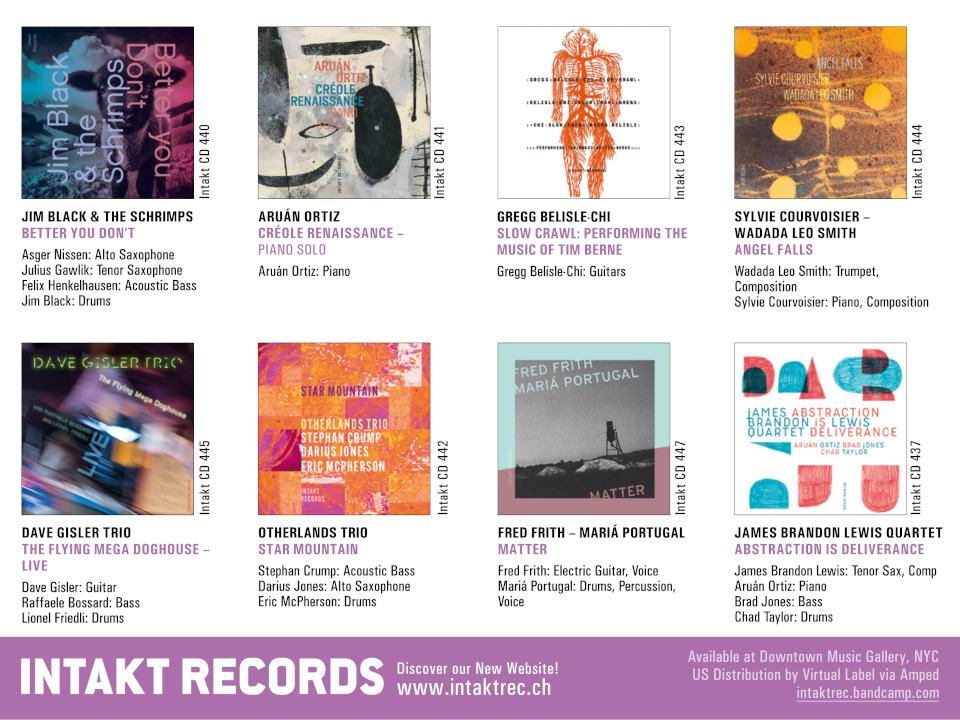Moment's Notice
Reviews of Recent Media
(continued)
Jimmy Bennington + Paul Blaney + Julian Priester
Blue Veils and Bright Stars
ThatSwan! 1013
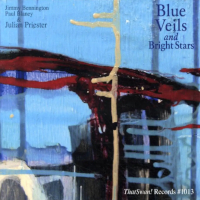 In March of 2005, drummer Jimmy Bennington, bassist Paul Blaney, and trombonist Julian Priester came together in Seattle’s Sonarchy Radio Studios to record a set of evocative, understated, and empathetic music. A mix of free improvisations, original compositions, and the evergreen “Mood Indigo,” Blue Veils and Bright Stars showcases a trio that pulls off exceptional pithy and focused performances. Each tune’s directness and individual character makes the disc’s hour of music go by faster than a watch might suggest. The album opens with “Another Realm,” on which Bennington’s loose drumming juxtaposed with Blaney’s rubato and searching bass lines creates an implied time and tempo foundation for Priester to enter with a series of punchy repeated notes. His staccato articulation and quick repetition become the recipe for his solo, during which his opening pitches become the homebase for short excursions into nearby territory. On “Churchbells,” the subdued ringing shimmer of Bennington’s cymbals suggest the sound and rhythms of the title’s referent. Blaney’s arco is rich, especially in the low end. The pair’s interaction sets up Priester, who appears with quiet and plaintive long tones that rest gently on plucked bass notes and Bennington’s mix of mallet, brushes, and sticks. Priester’s solo, as on “Another Realm,” is brief. He stays only as long as he needs to make his point, demonstrating the wisdom of an elder who needs little space to communicate what those with less experience would take twice as long to say. Priester’s treatment of “Mood Indigo” is delicate and tender, providing a moment for poignant reflection.
In March of 2005, drummer Jimmy Bennington, bassist Paul Blaney, and trombonist Julian Priester came together in Seattle’s Sonarchy Radio Studios to record a set of evocative, understated, and empathetic music. A mix of free improvisations, original compositions, and the evergreen “Mood Indigo,” Blue Veils and Bright Stars showcases a trio that pulls off exceptional pithy and focused performances. Each tune’s directness and individual character makes the disc’s hour of music go by faster than a watch might suggest. The album opens with “Another Realm,” on which Bennington’s loose drumming juxtaposed with Blaney’s rubato and searching bass lines creates an implied time and tempo foundation for Priester to enter with a series of punchy repeated notes. His staccato articulation and quick repetition become the recipe for his solo, during which his opening pitches become the homebase for short excursions into nearby territory. On “Churchbells,” the subdued ringing shimmer of Bennington’s cymbals suggest the sound and rhythms of the title’s referent. Blaney’s arco is rich, especially in the low end. The pair’s interaction sets up Priester, who appears with quiet and plaintive long tones that rest gently on plucked bass notes and Bennington’s mix of mallet, brushes, and sticks. Priester’s solo, as on “Another Realm,” is brief. He stays only as long as he needs to make his point, demonstrating the wisdom of an elder who needs little space to communicate what those with less experience would take twice as long to say. Priester’s treatment of “Mood Indigo” is delicate and tender, providing a moment for poignant reflection.
The effectiveness of the trio’s approach becomes most apparent when the threesome stray from it, as on “Blues Pulsar.” The medium-up tempo piece is a slightly off-center open blowing tune. Priester digs in and stretches out, exploring a larger range of ideas that are slightly out of keeping with his solos on the more focused cuts. The rhythm section also never quite hooks up, and the straight-ahead cooking post-bop feels forced. On the album’s longest piece, “Blount,” the music never settles into a direction or goal – another outlier for this otherwise unified trio.
The improvised “Across the Night Sky” finds Bennington stomping away on his hi hat with Blaney running, not walking, alongside. Priester releases bursts of rapid repeated notes and short phrases. There’s a fire here, as the rhythm section moves with enthusiasm and exuberance. Yet, Bennington and Blaney remain understated. A perfect mix of restraint and desire, maturity and passion. “Across the Night Sky II” closes the record. Bennington’s active drum solo sets up Priester, who appears as if a sunrise: with warmth he spreads across the landscape, pushing away what came before with the help of Blaney’s barely there walking bass line. When his story is told, Priester sets and recedes, as does this subtle and rich album.
–Chris Robinson
Olie Brice Quartet
All It Was
West Hill 005
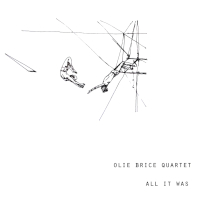 Hastings-based Olie Brice has been coming on strong for the past few years, developing an approach to composing for and leading small and mid-sized groups that lands in the Venn Diagram overlap between Charles Mingus, Dave Holland, and William Parker. The bassist’s themes are assertive yet accessible, often suggesting a resolution which is then sidestepped, resulting in distinctively shaped statements. Brice also has a sure touch in structuring his albums, giving them an arc that is satisfying without being formulaic.
Hastings-based Olie Brice has been coming on strong for the past few years, developing an approach to composing for and leading small and mid-sized groups that lands in the Venn Diagram overlap between Charles Mingus, Dave Holland, and William Parker. The bassist’s themes are assertive yet accessible, often suggesting a resolution which is then sidestepped, resulting in distinctively shaped statements. Brice also has a sure touch in structuring his albums, giving them an arc that is satisfying without being formulaic.
All It Was is his best to date, a compelling set from beginning to end. In his brief note, Brice relates to writing the six compositions while grieving the loss of his father against the backdrop of Gaza. However, this is not a monochromatic rage against the dying of the light. There is buoyancy, loft, and – and yes – swing in ample portions of the album, yet these contrasting moods do not dilute the heart of the matter, the touching, affect-free “Morning Mourning,” placed midway through the album.
On the contrary, the slinky swagger of the opening “Listening Intently to Raptors,” the bursting-at-the-seams exhilaration of “Happy Song for Joni,” and the Cuban heat of “And We Dance on the Firm Earth,” contribute to one of the more profound statements about the loss of a loved one expressed through music in recent years. Grief triggers a dredging of the mind’s scrapbook, images spanning everyday Zen and abject silliness that speak to the complexity and depth of filial and love relationships. The result is a vivid composite picture of a human condition.
While the vision for the album was acutely personal, the music is thoroughly collaborative. Will Glaser is the lesser known of Brice’s colleagues, at least outside the UK, but that may well be a temporary status, as the drummer consistently applies power and finesse in the right amounts at the right moments. As a tandem, Brice and Glaser simply excel, the proof being in the beginning-to-end sterling work of Rachel Musson and Alexander Hawkins.
All It Was is all a jazz album should be in the second quarter of the 21st Century.
–Bill Shoemaker
Dave Burrell + Sam Woodyard
The Lost Session – Paris 1979
NoBusiness NBCD 177
Misha Mengelberg + Sabu Toyozumi
The Analects of Confucius
NoBusiness NBCD 175
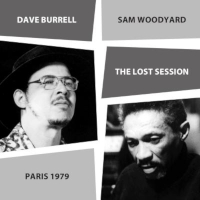
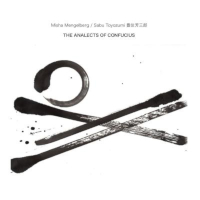 Two newly issued live recordings by short-lived piano-drum duos are ... OK. Dave Burrell and Sam Woodyard – insufficiently celebrated linchpin of the latter-day Ellington Orchestra with a galvanizing rimshot beat – were both based in Paris in 1979 and landed a three-month club gig, which got recorded in its closing weeks. An album for Horo was slated, but then that boutique Italian label folded. Burrell used the gig to polish repertoire for his Windward Passages Hawaiian-memoir solo recital for Hat Hut recorded a few weeks later – all the breezy tunes here are found on that album, save three standards: “Embraceable You,” “Lush Life” where they go big for the ending, and Duke’s “Sophisticated Lady.” Overlooking a live Marion Brown album later that year, Burrell wouldn’t record again ‘till 1987.
Two newly issued live recordings by short-lived piano-drum duos are ... OK. Dave Burrell and Sam Woodyard – insufficiently celebrated linchpin of the latter-day Ellington Orchestra with a galvanizing rimshot beat – were both based in Paris in 1979 and landed a three-month club gig, which got recorded in its closing weeks. An album for Horo was slated, but then that boutique Italian label folded. Burrell used the gig to polish repertoire for his Windward Passages Hawaiian-memoir solo recital for Hat Hut recorded a few weeks later – all the breezy tunes here are found on that album, save three standards: “Embraceable You,” “Lush Life” where they go big for the ending, and Duke’s “Sophisticated Lady.” Overlooking a live Marion Brown album later that year, Burrell wouldn’t record again ‘till 1987.
This Lost Session is decidedly casual, starting with the sound quality, dubbed from a cassette. The (upright?) piano was long overdue for a tuning. Woodyard declined to rehearse but wasn’t thrown by anything the pianist served up; when there’s a change-up or transition he just hangs back a second. It helps that Burrell’s tunes often evoke/stylize early-jazz and pre-jazz rhythms. He’s not a virtuoso but he’s very much at home on his own tunes, animating his catchy melodies and infectious groove numbers like “Black Robert” which Sam propels on (mostly) closed hi-hat. Midway through that one Burrell fixes on a rippling pattern that sounds practiced – and indeed, it briefly turns up on the live Windward Passages version (where solo play lets him toy with tempo more than with an accompanist). The left-hand part in Burrell’s signature earworm “A.M. Rag” is a little too regular for authentic ragtime, which liked the occasional hiccup; no matter, his fetching melodic/right-hand variations make the tune even catchier. “Sarah’s Lament” is in (and out) of a lithe light two-beat lilt that leans toward a reggae lope at one point; Woodyard’s brushes power the pulse and shore up the phrasing, and he gets down on Dave’s New Orleans-accented boogie-woogie “On a Saturday Night,” showing a glimmer of his old Ducal drive. But Sam never steps out like he’s the attraction. There’s nary a rimshot to be heard.
As many duo LPs, subscription flexidiscs, and CDs Misha Mengelberg and Han Bennink made between 1971 and 1998, the pianist’s posthumous Analects of Confucius recorded in concert in Shizuoka City in 2000 may be Mengelberg’s only documented duo with another drummer (where Bennink squared off with umpteen pianists). Misha had long since worked out strategies for dealing with headstrong Han who’d play louder and faster than he himself could or cared to. One reliable tack: lay out early on and let Han wear himself down. Then when energy levels are more equitable, play whatever you want to, as if ignoring him, and see if you can’t draw him in, with or without his noticing. Mengelberg treats Toyozumi much the same way – the impulsive Japanese drummer born a year after Bennink who (the liner note tells us) draws particular inspiration from the contrary Dutch pianist. So on their 40-minute opening set (dubbed “my guru MM”) Mengelberg plays on little cat feet for two minutes, then falls silent for 14-and-a-half, returning when Sabu settles down. Letting your partners hang out there on their own for so long is one way to get them to exhaust their pet materials. Toyozumi can ramble as he rumbles, and his big-beat syncopated patterns lack subtlety sometimes, but mostly he keeps moving. His brushwork, rolls, hi-hat technique, tom-tom tunings, and drive are notably looser than Bennink’s, and his cymbals sound darker, giving this combination its own character. He leaves more space. Misha’s belated return at 16:30 is a new beginning, spackled keys and brush rustle: real dialogue. Then he keeps paring back, to see how spare they can make it: very. Isolated piano notes; cymbal rattle. The pianist gets louder, softer, denser, leaner, leading the drummer along, at least till Toyozumi gets preoccupied with his own log-rolling. Where drums gets clomp-footed, piano may go the other way. Such hide-and-seek evasions are part of the game. Roller coaster momentum comes and goes during the crafty last 15 minutes, Misha cooling things down with a procession of chords for the finish.
Mengelberg plays a stately (new?) solo ballad for his devoted wife, “song for AMY,” at a slow-Monk gait; here he is sometimes his own ornery accompanist. Monk’s “Off Minor” is the encore. And there’s another (20-minute) duo jam, where Misha alternates among his discursive single-finger melodizing, pointedly unparsable scribble-scrambles, and a couple of readymades: the iterative “Koekoek” as heard on 1999’s Solo (on the Buzz label) and his early earworm march “Where Is the Police?” which he and Han had played on their duo debut ICP 10, to wrap things neatly up.
–Kevin Whitehead
Adegoke Steve Colson + Iqua Colson
Glow: Music for Trio ... And Voice
Silver Sphinx SS12405
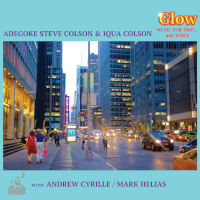 The AACM is commonly thought of as the incubator of disruptors, composers, and improvisers who overthrew norms to create radically experimental music. That narrative certainly holds up when discussing the early Delmark recordings of Muhal Richard Abrams, Anthony Braxton, and Roscoe Mitchell. However, the creative space opened by these artists was also cultivated by others for whom existing vernaculars were essential tools in refining personal languages. Some of the more extensively documented artists in this vein are Ernest Khabeer Dawkins and Nicole Mitchell. However, any comprehensive discussion of this aspect of the AACM’s history must stretch back at least to the 1970s and The Colson Unity Troupe.
The AACM is commonly thought of as the incubator of disruptors, composers, and improvisers who overthrew norms to create radically experimental music. That narrative certainly holds up when discussing the early Delmark recordings of Muhal Richard Abrams, Anthony Braxton, and Roscoe Mitchell. However, the creative space opened by these artists was also cultivated by others for whom existing vernaculars were essential tools in refining personal languages. Some of the more extensively documented artists in this vein are Ernest Khabeer Dawkins and Nicole Mitchell. However, any comprehensive discussion of this aspect of the AACM’s history must stretch back at least to the 1970s and The Colson Unity Troupe.
Beginning with 1978’s Triumph!, which inaugurated their Silver Sphinx imprint, pianist Adegoke Steve Colson and vocalist Iqua Colson have created a body of work that embraces use of core jazz practices and the bold exploration of abstraction. Even on the Troupe’s more provocative No Reservation (1981; Black Saint), there was a welcoming spirit, centered around Adegoke’s deft writing for Iqua’s luminous voice. That chemistry has ripened over decades, leaning more in recent years on uplifting lyricism and sleek rhythmic propulsion, but maintaining a distinctive, socially conscious fire. As the Colsons’ music has been scantily documented, the appearance of Glow: Music for Trio ... And Voice is cause to take note.
Like their previous albums, Glow is smartly constructed. As an opener, “Getting Comfortable” rhymes with “Lateen” on Triumph!; a percolating samba-infused trio piece, it presents Adegoke as a nimble soloist who dodges stock gambits and glaring namechecks. The Brazilian-tinge reemerges midway through the album with “Midnight Samba,” which plays to Iqua’s knack for emoting joy. Like every strong album, Glow has bracing pivot points. The most arresting is the turn from “Midnight Samba” to “Atrocities,” a searing indictment of hate, greed, and the corruption of values that Iqua delivers with just enough understatement to avoid pedantry, while still driving the point home. And strong albums don’t have to end with an exclamation point; an ellipsis more than suffices, as the tender closing title piece confirms.
Throughout the album, the Colsons are artfully aided and abetted by Andrew Cyrille and Mark Helias. As accompanists, they enhance every piece with expertly place dabs of color; as soloists, they reassert their mastery of the art with every phrase. They are a terrific tandem, essential to the success of the album. But make no mistake: the vision for Glow: Music for Trio ... And Voice is the Colsons’, a call for resilient passion.
–Bill Shoemaker
Ellery Eskelin Trio New York
About (or On)
First Visit ezz-thetics 2-117
 The latest in the First Visit series from ezz-thetics is About (or On), by Ellery Eskelin’s Trio New York. Featuring Gary Versace on B3 and drummer Gerald Cleaver, About (or On) is a two-disc set that combines the trio’s two studio albums: Trio New York (2011) and Trio New York II (2013). From almost the moment they arrived in my mailbox to the time of this writing – over two months – the two discs did not leave my five-CD changer. Other albums came and went, but About (or On) held fast throughout my rapidly changing tastes.
The latest in the First Visit series from ezz-thetics is About (or On), by Ellery Eskelin’s Trio New York. Featuring Gary Versace on B3 and drummer Gerald Cleaver, About (or On) is a two-disc set that combines the trio’s two studio albums: Trio New York (2011) and Trio New York II (2013). From almost the moment they arrived in my mailbox to the time of this writing – over two months – the two discs did not leave my five-CD changer. Other albums came and went, but About (or On) held fast throughout my rapidly changing tastes.
Eskelin, Versace, and Cleaver do not take the standard tenor-B3-drums trio approach that we all know and love. No grease. No barwalking. No obligatory blues heads quickly tossed aside in favor of extended blowing. One could call Trio New York a “standards trio,” but not in the sense of Keith Jarrett’s group. The titular “About (or On)” is an apt descriptor of the trio’s approach: it does not play standards so much as it reimagines, rearranges, responds to, and uses elements from them to create large scale explorations that may not venture very far into the tune’s familiar territory. Each title begins with “About (or On) ...” followed by a word that suggests or comments on the tune it is based on. For example, “About (or On) ... Conjuring” is based on “Witchcraft” and “About (or On) ... Endless” is “How Deep is the Ocean.” In this way, the trio is and is not playing these songs.
Their method is such that I find myself questioning just how well I know certain works. As much as I’ve internalized Bill Evans’ and Frank Sinatra’s versions of “Witchcraft” and played in big bands backing singers doing their own interpretation, I can barely pick out fragments from Trio New York’s fifteen-minute deconstruction. On the other hand, I hear “Just One of Those Things” – the tune and the changes – occurring throughout “Happenstance,” although mysteriously I keep hearing “On the Street Where You Live” at the same time. Is Eskelin quoting that tune? Is Versace playing some of its changes? Am I imagining it? I recognize the prominent short four-note melodic motif from “Lover Come Back to Me” that Eskelin repeats on “Desire,” as it stands out on a Nat King Cole recording of the tune. However, the motif is completely foreign to the Sinatra version I also know well. This is to say, listening to these two albums is almost an auditory game of hide and seek.
But it’s much more than that too. About (or On) is the product of a band whose members can go as inside or as interstellar as they want and who mix together equal parts risk, an appreciation of the unorthodox, and a deep absorption and respect for the tradition. Eskelin, Versace, and Cleaver turn each performance into a free form epic in which no tempo, meter, or lack thereof; no idea, no matter how bonkers or uncouth; no unabashed embrace of the path, are discouraged. On the first disc’s opener, “Rumination”/“Memories of You,” Eskelin and Versace both lay down rolling arpeggios. Later the band takes a stop/start/rubato approach in which slick tenor runs jut up against stomped bass notes. Cleaver teases a medium swing pattern and just when it feels like the right time to settle into something nice and easy, he pulls the football back and the trio goes further out than it began. Throughout both discs, Eskelin is an expert balladeer – his dry martini sound caresses the glacial treatment of “Celestial/“The Midnight Sun” – as well as a fiery sparring partner. Note how he boxes with Cleaver at the top of “Happenstance”/“Just One of those Things.” Eskelin also becomes a trickster or provocateur: he plays the melody of “How deep is the ocean, how high is the” and moves on to something unrelated, refusing to finish asking the main question. This prompts listeners to question “what exactly is the main question?” Cleaver is subtle and nimble. His fluid drumming helps drive the band’s multiple personality identity, whether that’s by setting a medium swing and slowly bumping it up into a blazing bop, creating tension by playing three against Versace’s four, or moving from mostly drums to all cymbals when a new soloist takes over. As on the restless “Monk”/“We See,” Cleaver often unleashes and shifts between numerous grooves and rhythmic ideas in a short amount of time that require and conjure inventive responses from Eskelin and Versace.
Versace is a bit of the group’s wild card. Where some organists “set it and forget it,” or maybe have a limited set of timbres and tones in their B3 toolkit, Versace works to unlock the instrument’s complete sonic possibilities. Sure, the big bluesy take-me-to-church sound is there, and he gets that single note percussive touch of Jimmy Smith, but he also loves a good creepy carnival organ and ear-piercing laser beams. At the top of “Celestial”/“The Midnight Sun,” he channels his inner Morton Subotnik with a series of blips, bloops, and blurps that could have come from a vintage Buchla synth. For minutes at a time he might just play with his feet. He will use the stops in the same way a modular synthesist might use a low pass filter or an envelope generator. He might try many of these things within a few minutes. At the end of “Endless”/“How Deep is the Ocean” he finishes his solo by going into a straight eighth, minimalist pattern that would sound perfect for the score of an X Files episode. If that was not quite weird enough, Eskelin comes back in, restating the head as if he was Ben Webster playing with Oscar Peterson. The juxtaposition is bizarre, unexpected, and exciting.
Of the two discs, the first is the most adventurous. While it has one less cut than the second, it is over seventeen minutes longer, which gives the trio a lot more time to stretch out and satisfy any whim it might have. If disc one is the twenty-three-year-old version of the band, disc two represents its maturer, thirty-five-year-old self: more focused, seasoned, and slightly less risk averse. Disc two is subtler and embraces a nice easy swing pocket more often. While the core identity of the band remains, its older self likes to hew closer to a form – upon hearing the turnaround at the end of a chorus it is not surprising when the next soloist steps up.
Trio New York excels at navigating the dichotomy between leap first, ask questions later and having the good sense to make sure the backup parachute works; between the surprising and the more tangible; between sublimated abstraction and a comforting familiarity with material that goes back nearly a century. It’s not simply about mixing free improvisation with straight-ahead playing. It’s about a band that built a wholly unique sound born from their interpretation of the dialectical relationship between the old and the new, in which they find a fresh way to understand and elucidate how both sides are expressed and defined in each other. A magisterial offering from what has become one of my favorite bands, About (or On) has given me some of the most rewarding and enjoyable listening I’ve had in a long time. It’s going right back in the CD player.
–Chris Robinson
